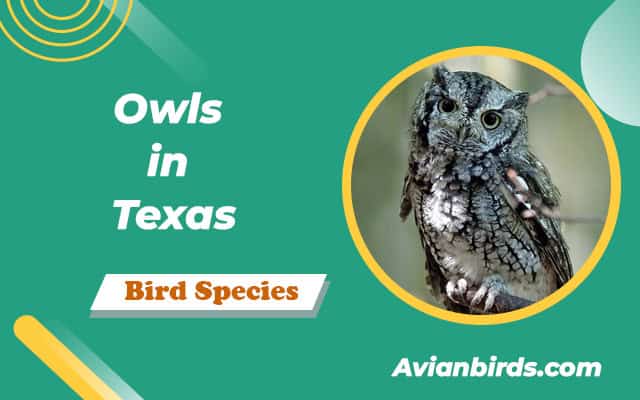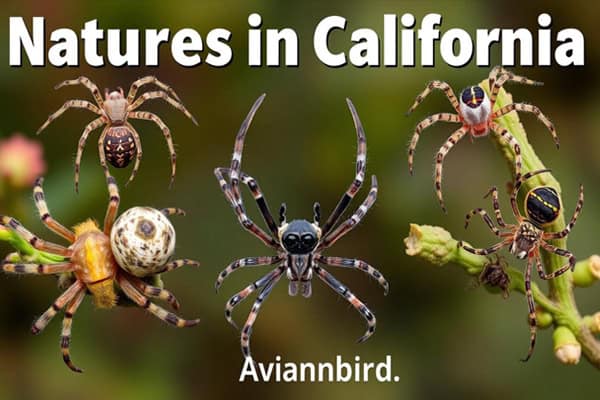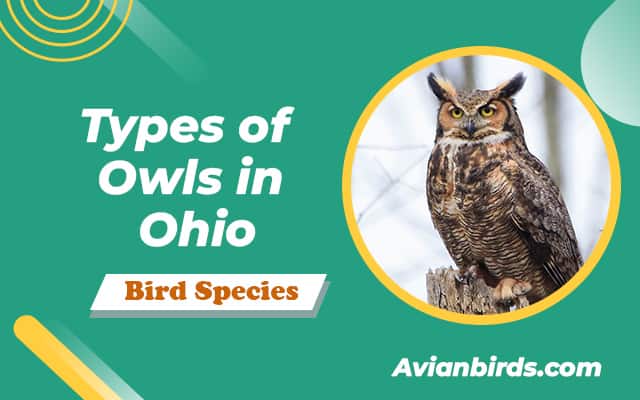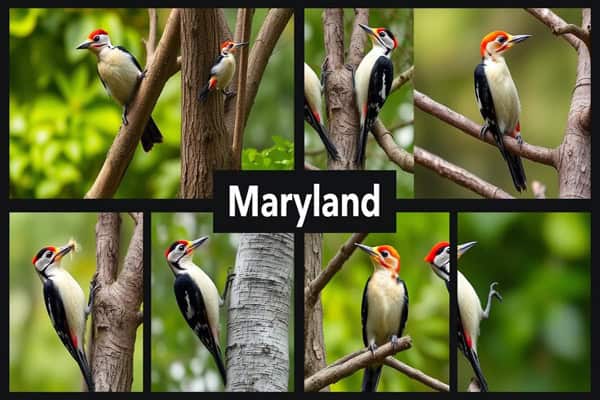8 Types of Owls in Texas (ID Guide With Pictures)
In Texas, Owls in Texas captivate with their nocturnal prowess. As a birder, I’ve researched these silent hunters who thrive across the state’s diverse landscapes. From the perches in dark woods to the vast, starlit skies, they’re a testament to nature’s mysteries, preying with precision. No matter where you wander in Texas, from Buffalo Lake to South Padre Island, you’re never far from an owl’s hoot or a birder’s paradise.
Here we’ll learn about 8 different types of owls in Texas
1. Short-eared Owl
- Scientific name – Asio flammeus
- Lifespan – 12 years (maximum recorded)
- Size – 13.4 to 16.9 in
- Weight – 7.3 to 16.8 oz
- Wingspan – 33.5 to 40.5 in
- Status – Least concern
The Short-eared Owl is not too big and has tiny ear tufts. Its back is a mix of white and tan with dark spots, and its belly is tan with brown lines. This owl has a pale face with dark spots near its bright yellow eyes.
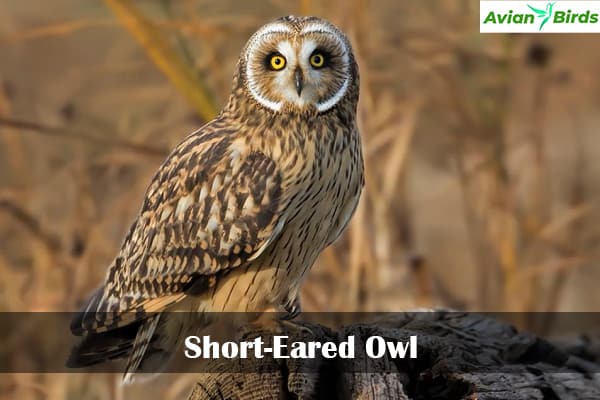
Firstly, the bottom of its wings is light-colored, but you can see dark bands on the tips and a dark mark on the “wrist.” Secondly, these owls are usually silent in Texas, except when they’re looking for a mate, then they might hoot.
Next, they build their nests on the ground, hidden in short plants and grass. The nest looks like a small, round dent in the soil, cozy with grass and soft feathers.
Moreover, mother owls lay up to eleven eggs, which take about three to five weeks to hatch. The baby owls stay in the nest for about two to three weeks before they’re ready to fly.
Lastly, Short-eared Owls eat lots of different animals, like small mammals and birds. They really like voles and mice, but they also hunt other small creatures and even some types of birds.
2. Great Horned Owl
- Scientific name – Bubo virginianus
- Lifespan – 28 years (maximum recorded)
- Size – (46 to 63 cm)
- Weight – 3 (910 to 2500 g)
- Wingspan – (101 to 145 cm)
- Status – Least concern
The Great Horned Owl is the big owl in Texas. It looks grey-brown and has big tufts on its ears. Their faces are grey or red-brown with spots on their bodies. Their throats are white, and their wings underneath are light.

These owls make loud hooting sounds like “hoo-hoo-hoo-hoo”.
They don’t build their own homes but use old nests made by other birds, like hawks or crows. Sometimes they live in holes in trees or old buildings. They make their nests comfy with soft feathers, leaves, and bark.
When they have babies, the female lays one to four eggs. The chicks hatch about a month later and leave the nest about six weeks after that.
Great Horned Owls are big hunters. They eat lots of different animals, even ones bigger than them. Their favorites are small mammals like mice and rabbits, and birds like coots.
3. Barred Owl
- Scientific name – Strix varia
- Lifespan – 26 years (maximum recorded)
- Size – (43 to 50 cm)
- Weight – (470 to 1050 g)
- Wingspan – (99 to 110 cm)
- Status – Least concern
The Barred Owl is a big owl with dark eyes, a yellow beak, and no ear tufts. It has a light-colored belly with horizontal stripes on the chest and vertical lines on the belly. Its back is brown with white speckles, and its wings and tail have brown stripes.

When it calls out, it sounds like it’s asking, “Who cooks for you? Who cooks for you all?”
These owls usually make their homes in holes in trees, but they might also use nests made by other animals or even special nest boxes. Sometimes they add lichen, plants, or feathers to their nests.
They lay between one to five eggs, which hatch after about a month. The babies leave the nest about a month after hatching.
Barred Owls mostly eat small mammals like rabbits, chipmunks, and mice. They also eat amphibians, reptiles, insects, fish, and birds.
Barred Owls aren’t in danger, and there are about 3.5 million of them. Their population has been growing slowly for the past fifty years.
4. Eastern Screech Owl
- Scientific name – Megascops asio
- Lifespan –14 years (maximum recorded)
- Size – (16 to 25 cm)
- Weight – (121 to 244 g)
- Wingspan – (48 to 61 cm)
- Status – Least concern
The Eastern Screech Owl is a small, round owl with tiny ear tufts. It’s mostly gray with thin dark lines and thicker vertical streaks. Its face is pale with yellow eyes and a dark beak.

In southern Texas, some of these owls have lighter beaks. There’s also a version with red feathers, darker streaks, and a line of white feathers underneath.
These owls make a trilling whiny sound.
They often make their homes in old tree holes made by squirrels or woodpeckers or in special nest boxes. They don’t add anything soft to their nests.
Females lay two to six eggs at a time. The eggs hatch after about a month, and the babies leave the nest about a month later.
They eat lots of different small animals like mice, rats, birds, frogs, lizards, crayfish, and insects.
5. Burrowing Owl
- Scientific name – Athene cunicularia
- Lifespan – 10 years (maximum recorded)
- Size – (19 to 25 cm)
- Weight – (140 to 240 g)
- Wingspan – (51 to 61 cm)
- Status – Least concern
The Burrowing Owl is a small owl without ear tufts but with long legs. It’s mostly dark brown with white or sandy spots on its back. Its belly is creamy with dark lines, and it has a brown head with yellow eyes, a white throat, white eyebrow marks, and a yellow beak.

They don’t make a lot of noise, but when they do, it’s a cooing sound with two notes.
These owls are called “burrowing” because they nest in holes in the ground. They usually use burrows made by other animals like prairie dogs, badgers, or ground squirrels. Sometimes they dig their own holes.
Their nests are often lined with things like grass, feathers, or even animal droppings.
They lay between two to twelve eggs at a time. The eggs hatch after about a month, and the babies leave the nest about a month and a half later.
They eat lots of different things like insects, small mammals, birds, lizards, and even snakes.
6. Barn Owl
- Scientific name – Tyto alba
- Lifespan – 15 years (maximum recorded)
- Size – (32 to 40 cm)
- Weight – (400 to 700 g)
- Wingspan – (100 to 125 cm)
- Status – Least concern
Barn Owls are medium-sized owls that look almost like ghosts and don’t have ear tufts. They have white bellies, while their backs are a mix of buffy cinnamon and grey. Their faces are white and shaped like a heart, with dark eyes.
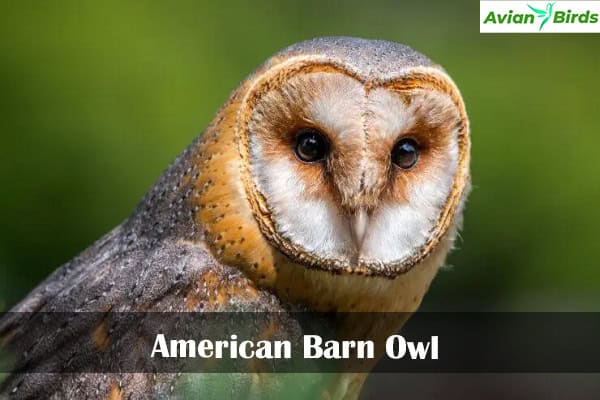
Instead of the typical owl hoot, they make a raspy scream.
These owls aren’t too fussy about where they make their homes. They’ll nest in all sorts of places like tree holes, cliff cracks, burrows, caves, old buildings, or even nest boxes. They make their nests using their own pellets, which they shape into a cup.
They can lay a lot of eggs at once, anywhere from two to eighteen. The eggs take about a month to hatch, and the babies stay in the nest for quite a while, around 50 to 55 days.
Barn Owls mostly eat small mammals like rats, mice, rabbits, and bats. Sometimes they’ll go after birds like blackbirds or starlings.
Luckily, Barn Owls are doing pretty well. Their population has been increasing over the last fifty years, and there are about 3.6 million of them.
7. Western Screech Owl
- Scientific name – Megascops kennicottii
- Lifespan – 14 years (maximum recorded)
- Size – (19 to 25 cm)
- Weight – (100 to 305 g)
- Wingspan – (55 to 62 cm)
- Status – Least concern
The Western Screech Owl is a small, chubby owl with tiny ear tufts. In Texas, they only come in a grey color. They have dark outlines around their light faces, dark beaks, and dark streaks on their lighter bellies. Their upper side has white marks, and they have yellow eyes.

They make a loud series of whistled hoots, which speed up at the end, sounding like a bouncing ping-pong ball.
These owls like to nest in holes in trees, often using old woodpecker nests. Sometimes they use natural holes in trees or very rarely holes in cliffs or banks. They might also use nest boxes in wooded areas.
Females lay between two to seven eggs at a time, which takes about a month to hatch. The babies stay in the nest for about 35 days after hatching.
Read Our Previous Articles:
8. Ferruginous Pygmy Owl
- Scientific name – Glaucidium brasilianum
- Lifespan – 7 years (maximum recorded)
- Size – 6.7 to 7.9 in
- Weight – 1.6 to 3.8 oz
- Wingspan – 14.6 to 16.1 in
- Status – Least concern
The Ferruginous Pygmy Owl is a small owl without ear tufts. Its feathers can be rusty-brown to grey-brown, and its back is plain. It has two dark patches behind its head that look like eyes.
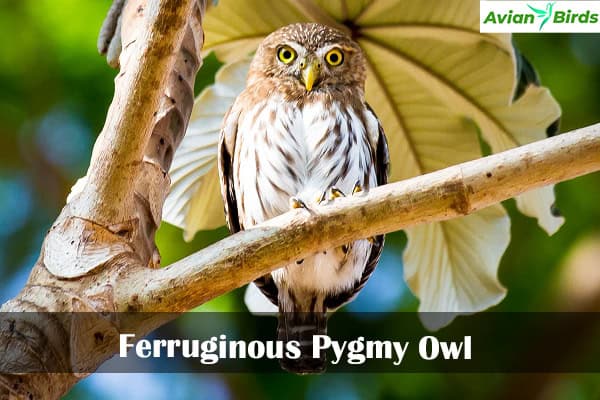
Its face has two white stripes above yellow eyes, and its underside is whitish with brown streaks.
These owls usually make a series of loud whistles.
They nest in old tree holes or big cacti holes, often ones made by woodpeckers or naturally formed.
They lay between three to five eggs at a time, and the eggs hatch after about a month. The babies leave the nest about a month after hatching.
They eat lots of insects like caterpillars, crickets, and beetles, as well as small birds, scorpions, small mammals, and lizards.
Ferruginous Pygmy Owls are doing okay overall, with around 50 million of them. But their numbers are going down because of things like losing their homes to things like building and farming.
Frequently Asked Questions
Q1. What kind of owls do they have in Texas?
Texas is home to several owl species, including the Great Horned Owl, Barn Owl, Eastern Screech Owl, Western Screech Owl, and more.
Q2. Are there owls in Dallas?
Yes, Dallas is part of Texas, so it’s possible to find various owl species there, depending on habitat and surroundings.
Q3. Do barn owls live in Texas?
Yes, barn owls do live in Texas. They are found in various habitats across the state, including rural areas, grasslands, and agricultural regions.
Q4. What is the largest owl in South Texas?
The Great Horned Owl is the largest owl species commonly found in South Texas. It’s known for its sizable appearance and prominent ear tufts.

